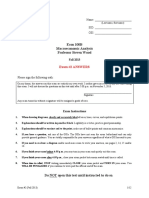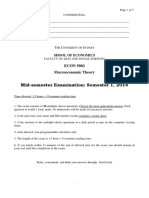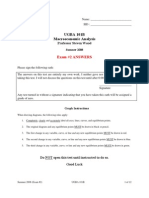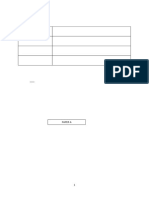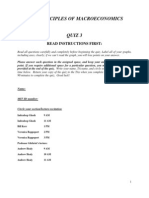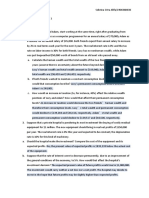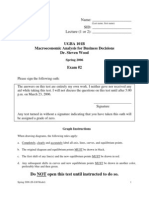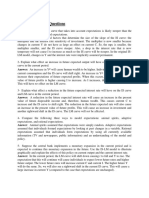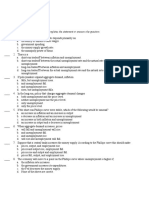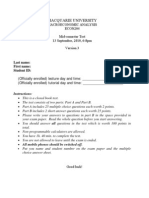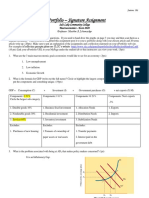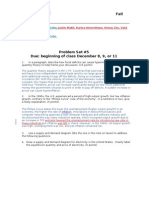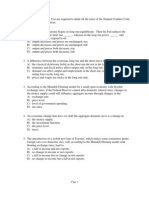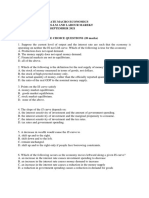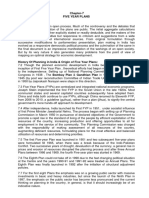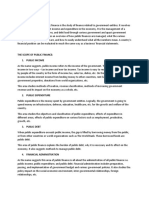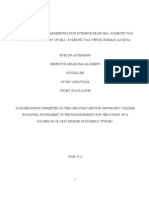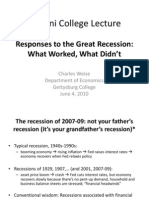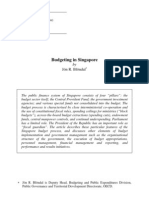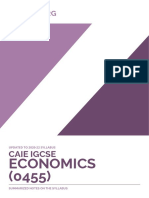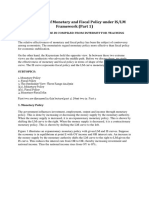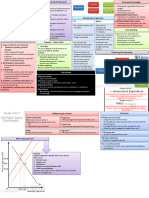Ugba 101B - Exam - 3 Answers - Spring 2013
Ugba 101B - Exam - 3 Answers - Spring 2013
Uploaded by
jessica_1292Copyright:
Available Formats
Ugba 101B - Exam - 3 Answers - Spring 2013
Ugba 101B - Exam - 3 Answers - Spring 2013
Uploaded by
jessica_1292Original Description:
Original Title
Copyright
Available Formats
Share this document
Did you find this document useful?
Is this content inappropriate?
Copyright:
Available Formats
Ugba 101B - Exam - 3 Answers - Spring 2013
Ugba 101B - Exam - 3 Answers - Spring 2013
Uploaded by
jessica_1292Copyright:
Available Formats
Exam #3 (Spring 2013) 1/12
Name: _________________________
(Last name, first name)
SID: _________________________
GSI: _________________________
Econ 100B
Macroeconomic Analysis
Professor Steven Wood
Spring 2013
Exam #3 ANSWERS
Please sign the following oath:
The answers on this exam are entirely my own work. I neither gave nor received any aid while taking this exam. I
will not discuss the questions on this test until after 6:00 p.m. on May 13, 2013.
_______________________________________
Signature
Any exam turned in without a signature will be assigned a grade of zero.
Exam Instructions
1. When drawing diagrams, clearly and accurately label all axes, lines, curves, and equilibrium points.
2. Explanations should be written in pencil or black. Legibility is a virtue; practice good penmanship.
3. Explanations should be succinct and to the point; make use of bullet points and common mnemonics.
4. If you have a question, ask one of the GSIs. The GSIs have not seen the exam beforehand and can only
provide general guidance. You are totally responsible for your answers regardless of what a GSI has said to you.
5. If you need to re-draw a diagram and/or need more room to write your answers, use pages 2, 14, 15 and/or
16.
6. The exam will end promptly at 6:00 p.m. When time is called, STOP writing, immediately CLOSE your
exam packet and TURN IN your exam. You WILL BE PENALIZED if you continue to write past the official
end of the exam.
Do NOT open this test until instructed to do so.
Exam #3 (Spring 2013) 2/12
A. Multiple Choice Questions (30 points). Highlight the best answer (3 points each).
1. A negative shock to aggregate demand will likely result in:
a. A permanent change in output if the central bank responds by lowering the real interest rate.
b. No permanent change in equilibrium inflation unless the central bank responds by lowering the
real interest rate.
c. An eventual increase in short-run aggregate supply for any inflation rate if the central bank
responds by lowering the real interest rate.
d. All of the above.
e. None of the above.
2. An emphasis on inflation stability is compatible with a non-activist stance only when the shocks to the
macroeconomy are:
a. Permanent supply shocks.
b. Temporary supply shocks.
c. Aggregate demand shocks.
d. Aggregate demand and permanent supply shocks.
e. Aggregate demand and temporary supply shocks.
f. Temporary supply and permanent supply shocks.
g. All of the above.
h. None of the above.
3. With autonomous changes in the policy interest rate, i.e., changes to r, the Federal Reserve cannot
determine the long-run equilibrium real interest rate or potential output and will only be able to determine
inflation. This statement is consistent with:
a. The long-run neutrality of money.
b. The idea that nominal and real variables are independent of each other in the long-run.
c. Shifts in the MP curve may lead to shifts in the AD and AS curve but the LRAS curve remains
unchanged.
d. All of the above.
e. None of the above.
4. When pursuing short-run stabilization policies, if monetary policy is used to maintain real economic output
at potential, then long-run economic growth will be slower the _____ is fiscal policy and the _____ is the
real interest rate.
a. tighter; higher
b. tighter; lower
c. easier; higher
d. easier; lower
Exam #3 (Spring 2013) 3/12
5. Ricardian Equivalence assumes that:
a. Government spending remains constant.
b. Many people are subject to borrowing constraints.
c. Tax cuts have a positive impact on aggregate supply.
d. An anticipated increase in the income of future generations does not deter saving today on their
behalf.
6. Suppose that both Country A and Country B are initially in general equilibrium with flexible exchange
rates and perfect capital mobility. If Country A then experiences a negative short-run aggregate supply
shock, then Country As currency would:
a. Appreciate in the short-run and appreciate in the long-run.
b. Appreciate in the short-run but depreciate in the long-run.
c. Appreciate in the short-run and not change in the long-run.
d. Depreciate in the short-run but appreciate in the long-run.
e. Depreciate in the short-run and depreciate in the long-run.
f. Depreciate in the short-run and not change in the long-run.
7. In an open economy with a flexible exchange rate and perfect capital mobility, the government expenditure
multiplier would be:
a. Larger than in a closed economy.
b. Smaller than in a closed economy.
c. The same as in a closed economy.
d. Indeterminate; it could be either larger or smaller than in a closed economy.
8. A fixed exchange rate is preferable to a flexible exchange rate because:
a. Fiscal policy is more effective in stabilizing inflation.
b. Monetary policy is more effective in stabilizing inflation.
c. Fiscal policy is more effective in stabilizing economic output.
d. Monetary policy is more effective in stabilizing economic output.
e. All of the above.
f. None of the above.
Exam #3 (Spring 2013) 4/12
9. Which of the following would be a violation of the rational expectations assumption?
a. Over the past 20 years, people have consistently under-predicted the inflation rate for the
following year.
b. Over the past 20 years, people have never (even once) accurately predicted the inflation rate for
the following year.
c. The Feds announcement that it might ease interest rates caused an immediate drop in short-term
rates, even before the Fed took any action.
d. All of the above.
e. None of the above.
10. Assume that rational expectations hold. Now suppose that the central bank announces that it intends to raise
its policy interest rate startingin2014ratherthanin2016.This announcement would likely cause:
a. The current IS curve to shift to the left and the current MP curve to shift down.
b. The current IS curve to shift to the right and the current MP curve to shift down.
c. The current IS curve to shift to the left and the current MP curve to shift up.
d. The current IS curve to shift to the right and the current MP curve to shift up.
e. The current IS curve to shift to the left and the current MP curve to not change.
f. The current IS curve to shift to the right and the current MP curve to not change.
g. No change in the current IS curve but the current MP curve to shift up.
h. No change in the current IS curve but the current MP curve to shift down.
Exam #3 (Spring 2013) 5/12
B. Analytical Questions (70 points). Answer BOTH of the following questions based on the standard models of
analysis developed in class. The information in the various parts of the questions is sequential and cumulative.
1. The AD/AS Model (35 points). Suppose that the economy, which is characterized by sticky wages and
prices, is initially in general equilibrium and that supply-side assumptions hold.
a. Based only on this information, use an AD/AS diagram to clearly and accurately show the
economys initial (1) economic output and (2) inflation. These diagrams should be drawn in
BLACK.
AD
2
LRAS
0
AD
0
SRAS
0
(
e
=
0
)
Y
P
0
Y
2
Y
1
Y
0
= Y
P
0
Y
2
=
0
1a
LRAS
1
AD
1a
AD
1
SRAS
1
(
e
=
0
)
SRAS
2
(
e
=
1
)
Exam #3 (Spring 2013) 6/12
b. In Year 1, because of massive budget deficits and a rapidly rising debt-to-GDP ratio, the
government compromised by (1) permanently reducing government purchases by $200 billion and
(2) permanently increasing marginal income tax rates to generate an additional $200 billion in tax
revenue. Incorporating only this additional information, clearly and accurately show in your
diagram above the Year 1 effects, if any, this would have on the economys (1) economic output
and (2) inflation. These effects should be drawn in RED.
c. Provide an economic explanation of what you have shown in your diagrams above. Discuss
what, if anything, happens in Year 1 to the economys (1) economic output and (2) inflation. Be
sure to explain why these effects take place.
In Year 1, the reduction in government purchases by $200 billion would reduce aggregate
demand for any given inflation rate. This can be represented by a leftward shift of the
aggregate demand curve from AD
0
to AD
1a
.
The permanent increase in the marginal income tax rate that would generate $200 billion of
additional tax revenue would reduce disposable income, causing a decline in consumer
spending by the marginal propensity to consume multiplied by $200 billion. This would
reduce aggregate demand at any given inflation rate. This can be represented by a leftward
shift of the aggregate demand curve from AD
1a
to AD
1
(which is smaller than the leftward
shift of the aggregate demand curve from AD
0
to AD
1a
.)
Because supply-side assumptions hold, the permanent increase in the marginal income tax
rate would also reduce the incentives to work and investment, resulting in a negative long-
run aggregate supply shock. This can be represented by a leftward shift of the long-run
aggregate supply curve from LRAS
0
to LRAS
1
and an upward shift of the short-run
aggregate supply curve from SRAS
0
(
e
=
0
) to SRAS
1
(
e
=
0
).
As a result of these various changes to aggregate demand and aggregate supply, a new short-
run equilibrium is established with economic output declining from Y
0
to Y
1
and with
inflation declining from
0
to
1
.
Exam #3 (Spring 2013) 7/12
d. In Year 2, the central bank decides to target the inflation rate at its initial general equilibrium
level. Incorporating only this additional information, clearly and accurately show in your
diagram above the Year 2 effects, if any, on the economys (1) economic output and (2) inflation.
These effects should be drawn in BLUE.
e. Provide an economic explanation of what you have shown in your diagrams above. Discuss
what, if anything, happens in Year 2 to the economys (1) economic output and (2) inflation. Be
sure to explain why these effects take place.
In Year 2, two separate events occur.
First, because of the leftward shift of the long-run aggregate supply curve, expected
inflation in Year 1 has declined to
1a
which is below actual inflation of
1
. Because
inflation expectations are formed by a one-period (year) adaptive process, in Year 2
expected inflation will increase from
1a
to
1
. This can be represented by an
upward shift of the short-run aggregate supply curve from SRAS
1
(
e
=
0
) to
SRAS
2
(
e
=
1
).
Second, the central bank decides to target the inflation rate at its initial general
equilibrium level. In order to do so, the central bank will conduct a contractionary
monetary policy, increasing the real interest rate for any given inflation rate. This
increase in the real interest rate would reduce aggregate demand for any given
inflation rate. This can be represented by a leftward shift of the aggregate demand
curve from AD
1
to AD
2
.
As a result of these changes, economic output has declined from Y
1
to Y
2
and inflation has
increased from
1
to
2
=
0
.
Exam #3 (Spring 2013) 8/12
2. The Open Economy AD/AS Model with a Foreign Exchange Market (35 points).
a. Suppose that Country A has an open economy which is characterized by perfect capital mobility and sticky wages and prices. Country A is
initially in general equilibrium and has a flexible exchange rate. Based only on this information, use an AD AS diagram (on the left) and a
Foreign Exchange diagram (on the right) to clearly and accurately show Country As initial (1) economic output, (2) inflation, and (3)
exchange rate (using a direct quotation). These diagrams should be drawn in BLACK.
Y
2
Y
1
Y
0
= Y
P
Y
2
AD
0
SRAS
0
(
e
=
0
)
LRAS
E
E
2
=
E
1
=
E
par
E
0
Q
$
Q
$
D
$0
S
$
D
$1
SRAS
1
(
e
=
0
)
AD
1
SRAS
2
(
e
=
1
)
AD
2a
AD
2
Exam #3 (Spring 2013) 9/12
b. In Year 1, Country As government decides to peg the exchange rate at an overvalued level, a
level that the central bank commits to maintaining. Incorporating only on this additional
information, clearly and accurately show in your diagrams above the Year 1 effects of this
decision on Country As (1) economic output, (2) inflation, and (3) exchange rate These effects
should be drawn in RED.
c. Provide an economic explanation of what you have drawn in your diagrams above. Be sure to
discuss what happens to Country As (1) economic output, (2) inflation, (3) exchange rate, and
(4) net exports and explain why these changes take place.
In Year 1, Country A pegs the exchange rate at an overvalued level. In order to do so, the
central bank must sell some of its international reserves and buy its domestic currency. This
will reduce the domestic money supply and increase the real interest rate for any given
inflation rate. This can be represented by a leftward shift of the aggregate demand curve
from AD
0
to AD
1
.
The increase in Country As real interest rate makes Country As domestic currency
denominated assets more attractive. This can be represented by a rightward shift of the
demand curve for Country As domestic currency denominated assets from D
$0
to D
$1
. As a
result, the exchange rate will appreciate from E
0
to E
1
= E
par
, the pegged (or fixed) exchange
rate value.
The appreciation of Country As currency from E
0
to E
1
= E
par
reduces the cost of foreign
goods imported into Country A. As a result, Country A experiences a favorable short-run
aggregate supply shock. This can be represented by a downward shift of the short-run
aggregate supply curve from SRAS
0
(
e
=
0
) to SRAS
1
(
e
=
0
).
As a result of these changes, Country As economic output has declined from Y
0
= Y
P
to Y
1
,
inflation has declined from
0
to
1
, the exchange rate has appreciated from E
0
to E
1
= E
par
,
and net exports have declined (because the stronger currency reduces exports and increases
imports).
Exam #3 (Spring 2013) 10/12
d. Clearly explain the specific steps that Country As central bank must undertake in order to
maintain the countrys fixed exchange rate. Be sure to discuss what happens to the central banks
balance sheet.
In order to maintain the countrys fixed exchange rate the central bank must sell some of its
international reserves and buy its domestic currency. This will reduce the domestic money
supply and increase the nominal and real interest rate.
The central banks balance sheet will declinethe central bank loses assets (the
international reserves that it had been holding) and also loses liabilities (the domestic money
supply is smaller so there has been a decline in currency outstanding and/or in bank reserves
held at the central bank).
Exam #3 (Spring 2013) 11/12
e. In Year 2, Country A experiences a large negative aggregate demand shock. Incorporating only
this additional information, clearly and accurately show in your diagrams above the subsequent
Year 2 effects of this negative aggregate demand shock on Country As (1) economic output, (2)
inflation, and (3) exchange rate. These effects should be drawn in BLUE.
f. Provide an economic explanation of what you have drawn in your diagrams above. Be sure to
discuss what happens to Country As (1) economic output, (2) inflation, (3) exchange rate, and
(4) net exports and explain why these changes take place.
In Year 2, three separate events occur.
First, expected inflation in Year 1 was greater than actual inflation in Year 1, i.e.,
e
1
=
0
>
1
. Because inflation expectations are formed by a one-period (year)
adaptive process, in Year 2 expected inflation will decreases from
0
=
1
. This can
be represented by a downward shift of the short-run aggregate supply curve from
SRAS
1
(
e
=
0
) to SRAS
2
(
e
=
1
).
Second, the large negative aggregate demand shock would reduce economic output
at any given inflation rate. This can be represented by a leftward shift of the
aggregate demand curve from AD
1
to AD
2a
.
Third, both the downward adjustment of expected inflation and the negative
aggregate demand shock would lead to lower inflation and to a lower real interest
rate (along the MP curve).
If left unchecked this would reduce the demand for Country As domestic currency
denominated assets and cause a depreciation of Country As currency.
In order to maintain the fixed exchange rate at E
par
, the central bank must sell some
of its international reserves and buy its domestic currency. This reduces Country
As domestic money supply, causing the real interest rate to increase, maintaining
the demand for Country As domestic currency denominated assets.
However, this also reduces aggregate demand for any given inflation rate. This can
be represented by a leftward shift of the aggregate demand curve from AD
2a
to AD
2
.
As a result of these changes, Country As economic output has declined from Y
1
to Y
2
,
inflation has declined from
1
to
2,
the exchange rate remained at its fixed value so E
2
= E
par
,
and net exports were unchanged (because the fixed exchange rate was maintained).
Exam #3 (Spring 2013) 12/12
g. Identify and clearly explain two advantages and two disadvantages of Country A having a fixed
exchange rate.
Advantages of having a fixed, overvalued currency:
1. The fixed exchange rate provides a nominal anchor for the central bank, helping the
central bank establish its credibility.
2. The fixed exchange rate helps maintain low inflation if the anchor currency country
has low inflation.
3. Increased imports because foreign goods are now less expensive. This benefits
domestic consumers that buy imported goods and benefits domestic businesses (and
their employees) that depend on imported goods and/or inputs.
Disadvantages of having a fixed, overvalued currency:
1. Country A gives up its ability to have an independent monetary policy by having
both a fixed currency and perfect capital mobility. This means that monetary policy
cannot be used to offsets either domestic aggregate demand shocks to the economy.
2. Country As gives up its ability to have an independent monetary policy by having
both a fixed currency and perfect capital mobility. This means that monetary policy
cannot be used to offset aggregate demand or aggregate supply shocks in the anchor
currencys economy.
3. Reduced exports because Country As exports are now more expensive in the rest of
the world. This disadvantages businesses (and their employees) of export-oriented
businesses.
You might also like
- Question and Answer - 2Document30 pagesQuestion and Answer - 2acc-expertNo ratings yet
- Econ2123 Final - PracticeDocument3 pagesEcon2123 Final - PracticeMarco ChanNo ratings yet
- Public Economics in India J R Gupta PDFDocument614 pagesPublic Economics in India J R Gupta PDFAKHILA B S87% (15)
- Exam - 3 Answers - Fall 2013Document10 pagesExam - 3 Answers - Fall 2013jessica_1292No ratings yet
- 100 B Exam 2Document12 pages100 B Exam 2Maaz Khan AlviNo ratings yet
- Problem+Set+ 4+ Spring+2014,+0930 - 3Document8 pagesProblem+Set+ 4+ Spring+2014,+0930 - 3jessica_1292No ratings yet
- 2013 S2 Econ1016Document22 pages2013 S2 Econ1016Tom AfaNo ratings yet
- Midterm AnsDocument7 pagesMidterm AnsmariaNo ratings yet
- Tutorial 3Document5 pagesTutorial 3Tu QuyenNo ratings yet
- Ugba 101b Test 2 2008Document12 pagesUgba 101b Test 2 2008Minji KimNo ratings yet
- E - Portfolio Assignment MacroDocument8 pagesE - Portfolio Assignment Macroapi-316969642No ratings yet
- Final Econ e PortfolioDocument7 pagesFinal Econ e Portfolioapi-317164511No ratings yet
- Chapter 23Document12 pagesChapter 23php19xxNo ratings yet
- TBS Final Exam MACRO 2017Document6 pagesTBS Final Exam MACRO 2017OussemaNo ratings yet
- Economics Ansswers/solutionsDocument11 pagesEconomics Ansswers/solutionsPramod kNo ratings yet
- CH 14Document100 pagesCH 14Setiady MaruliNo ratings yet
- 4.3.4 Macro PracticeDocument6 pages4.3.4 Macro Practicebuiclara07No ratings yet
- Eco11b1 Fse11b1Document14 pagesEco11b1 Fse11b1Luyanda MkhizeNo ratings yet
- Unit 3 Review Session Original KEYDocument6 pagesUnit 3 Review Session Original KEYHenry DunaNo ratings yet
- 14.02 Principles of Macroeconomics: Read Instructions FirstDocument11 pages14.02 Principles of Macroeconomics: Read Instructions Firstamrith vardhanNo ratings yet
- MULTIPLE CHOICE. Choose The One Alternative That Best Completes The Statement or Answers The QuestionDocument4 pagesMULTIPLE CHOICE. Choose The One Alternative That Best Completes The Statement or Answers The QuestionTrúc LinhNo ratings yet
- DSE Past Paper ADAS and Monetary and Fiscal PolicyDocument13 pagesDSE Past Paper ADAS and Monetary and Fiscal Policypeter wongNo ratings yet
- Final ReviewDocument9 pagesFinal ReviewdragopyreNo ratings yet
- Homework 7 Macroeconomi 1Document5 pagesHomework 7 Macroeconomi 1sebrina citraNo ratings yet
- Practice Final ExamDocument9 pagesPractice Final ExamrbhagatNo ratings yet
- Suggested Answers Exercise Question Beeb3023 Intmd Macro A221Document15 pagesSuggested Answers Exercise Question Beeb3023 Intmd Macro A221Amirul AimanNo ratings yet
- Name: Nicholas BruneDocument10 pagesName: Nicholas BruneNicholas James BruneNo ratings yet
- E-Portfolio - Signature Assignment: Professor: Heather A SchumackerDocument9 pagesE-Portfolio - Signature Assignment: Professor: Heather A Schumackerapi-213470756No ratings yet
- Economics 100B - Spring 2006 - Wood - Midterm 2Document8 pagesEconomics 100B - Spring 2006 - Wood - Midterm 2lalalee12345678No ratings yet
- MarketingDocument4 pagesMarketingjyotiprakash giriNo ratings yet
- Sample Exam QuestionsDocument13 pagesSample Exam QuestionsavivhanukaNo ratings yet
- Final Exam Practice QuestionsDocument3 pagesFinal Exam Practice Questionsrobin70929No ratings yet
- ECON 203 Midterm 2012W AncaAlecsandru SolutionDocument8 pagesECON 203 Midterm 2012W AncaAlecsandru SolutionexamkillerNo ratings yet
- Answers - Sheet 7Document3 pagesAnswers - Sheet 7El jokerNo ratings yet
- CH21Document4 pagesCH21charlie simoNo ratings yet
- Exam 2, Principles of Macroeconomics (Econ 102) : Form 1Document10 pagesExam 2, Principles of Macroeconomics (Econ 102) : Form 1John DoeNo ratings yet
- Econ2123 18fall Practicefinal SolutionDocument17 pagesEcon2123 18fall Practicefinal SolutionwucorlinNo ratings yet
- Final Assignment - ECO 104Document10 pagesFinal Assignment - ECO 104Md. Rezwan Hossain Sakib 1711977630No ratings yet
- CB2402 Week 7Document5 pagesCB2402 Week 7RoyChungNo ratings yet
- Mid TestDocument8 pagesMid Testseven_jason_guo0% (1)
- Homework 3Document5 pagesHomework 3CHUA JO ENNo ratings yet
- Practice Midterm 2Document6 pagesPractice Midterm 2Swapan Kumar SahaNo ratings yet
- Ansreview 3 BDocument9 pagesAnsreview 3 BpartlinemokhothuNo ratings yet
- Assignment 2 MacroDocument6 pagesAssignment 2 MacroDeepa KhatriNo ratings yet
- Q& A 1Document6 pagesQ& A 1Mohannad HijaziNo ratings yet
- E - Portfolio Assignment Mike KaelinDocument9 pagesE - Portfolio Assignment Mike Kaelinapi-269409142No ratings yet
- Chapter 10 AnswerDocument18 pagesChapter 10 AnswerKathy WongNo ratings yet
- ECON 100B - Fall 2011 - Wood - Midterm 3 (Solution)Document9 pagesECON 100B - Fall 2011 - Wood - Midterm 3 (Solution)Jennifer WangNo ratings yet
- E - Portfolio Assignment-1 Econ 2020 Valeria FinisedDocument7 pagesE - Portfolio Assignment-1 Econ 2020 Valeria Finisedapi-317277761No ratings yet
- ECN204 Final 2011FDocument13 pagesECN204 Final 2011Fexamkiller100% (1)
- Quiz #3, Answers: 14.02 Principles of MacroeconomicsDocument10 pagesQuiz #3, Answers: 14.02 Principles of MacroeconomicsEmmanuel MbonaNo ratings yet
- macroII Ecofin Final Exam May2020 PartaDocument5 pagesmacroII Ecofin Final Exam May2020 PartaSebastian BurgosNo ratings yet
- E - Portfolio Assignment-1Document7 pagesE - Portfolio Assignment-1api-280064053No ratings yet
- Chapter 15 Practice QuestionsDocument10 pagesChapter 15 Practice QuestionsAbigail CubasNo ratings yet
- Module 17 Practice Set 1Document5 pagesModule 17 Practice Set 1Ian LuNo ratings yet
- PS5 - F10 KZ v3Document7 pagesPS5 - F10 KZ v3Vaid RamNo ratings yet
- PracticDocument7 pagesPracticyourmaxaluslifeNo ratings yet
- Final For Physics 1203Document8 pagesFinal For Physics 1203kmartdetectiveNo ratings yet
- IS LM Labor AssignmentDocument6 pagesIS LM Labor AssignmentNICHIKATAZI ENTERTAINMENTNo ratings yet
- Financial Plans for Successful Wealth Management In Retirement: An Easy Guide to Selecting Portfolio Withdrawal StrategiesFrom EverandFinancial Plans for Successful Wealth Management In Retirement: An Easy Guide to Selecting Portfolio Withdrawal StrategiesNo ratings yet
- Macroeconomic Essentials, fourth edition: Understanding Economics in the NewsFrom EverandMacroeconomic Essentials, fourth edition: Understanding Economics in the NewsNo ratings yet
- Syba Economics Syll 20-21Document13 pagesSyba Economics Syll 20-21Saniya ShaikhNo ratings yet
- Chapter-7 Five Year PlansDocument13 pagesChapter-7 Five Year PlansYasir SheikhNo ratings yet
- BS (Commerce)Document107 pagesBS (Commerce)GhazaliGulNo ratings yet
- Public Finance (Sharbani)Document5 pagesPublic Finance (Sharbani)Sumitava PaulNo ratings yet
- Project FileDocument16 pagesProject FileAnnieNo ratings yet
- Finance and Fiscal Policy For DevelopmentDocument32 pagesFinance and Fiscal Policy For DevelopmentFahad khanNo ratings yet
- Our FrameworkDocument5 pagesOur FrameworkbienvillecapNo ratings yet
- Challenges of Tax Administration EvidenceDocument69 pagesChallenges of Tax Administration EvidenceJohn Bates Blankson0% (1)
- BIS Bulletin-Central Banks' Response To Covid in Advanced EconomiesDocument9 pagesBIS Bulletin-Central Banks' Response To Covid in Advanced EconomiesGABRIEL ALEXANDER ROLDAN SANCHEZNo ratings yet
- Real Business Cycles and New Keynesian EconomicsDocument6 pagesReal Business Cycles and New Keynesian EconomicsMesum HashimNo ratings yet
- The Impact of Industrialization On Economic Growth: The Nigeria EXPERIENCE (2000-2013)Document11 pagesThe Impact of Industrialization On Economic Growth: The Nigeria EXPERIENCE (2000-2013)habtamuNo ratings yet
- Philippine Budget CycleDocument35 pagesPhilippine Budget CycleJetJet Linso100% (12)
- Aggregate Demand and Aggregate SupplyDocument12 pagesAggregate Demand and Aggregate Supplyluyna4706No ratings yet
- Alumni College Lecture: Responses To The Great Recession: What Worked, What Didn'tDocument38 pagesAlumni College Lecture: Responses To The Great Recession: What Worked, What Didn'tapi-13022074No ratings yet
- Inflation in MalaysiaDocument6 pagesInflation in MalaysiaPrince DesperadoNo ratings yet
- Budgeting in SingaporeDocument42 pagesBudgeting in Singaporejoelfirenze6084No ratings yet
- 10 Recommendations To Help Reduce Youth Unemployment Through EntrepreneurshipDocument32 pages10 Recommendations To Help Reduce Youth Unemployment Through EntrepreneurshipAprianusNo ratings yet
- Caie Igcse Economics 0455 Theory v1Document16 pagesCaie Igcse Economics 0455 Theory v1Mehri MustafayevaNo ratings yet
- 203 Sample Midterm3 AnswersDocument13 pages203 Sample Midterm3 AnswersMarilyne JinNo ratings yet
- Me Mid Term Question PaperDocument3 pagesMe Mid Term Question Papervansh sharmaNo ratings yet
- Effectiveness of Monetary and Fiscal Policy Under IS/LM Framework (Part 1)Document8 pagesEffectiveness of Monetary and Fiscal Policy Under IS/LM Framework (Part 1)Danny Farhan AlwajdiNo ratings yet
- Lecture 9 Fiscal PolicyDocument53 pagesLecture 9 Fiscal PolicyAmjid HussainNo ratings yet
- The Wall Street Journal Asia November 14 2016Document22 pagesThe Wall Street Journal Asia November 14 2016Hameleo1000No ratings yet
- British AirwaysDocument29 pagesBritish AirwaysAddy D'silva0% (1)
- NCRE - Sample Exam - 2007Document18 pagesNCRE - Sample Exam - 2007MiaDjojowasito100% (1)
- Namibia Mining GuideDocument38 pagesNamibia Mining GuideMinecs100% (1)
- Morgan Stanley 2021 Global Macro OutlookDocument10 pagesMorgan Stanley 2021 Global Macro Outlooksharmila singhNo ratings yet
- J Bradford DelongDocument45 pagesJ Bradford DelongTBP_Think_TankNo ratings yet
- ECS1601-chapter 3Document2 pagesECS1601-chapter 3Sanelisiwe Thanduxolo GasaNo ratings yet




